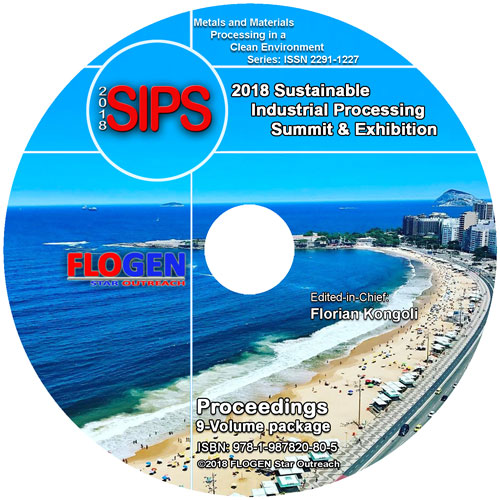2018-Sustainable Industrial Processing Summit
SIPS2018 Volume 2. Amatore Intl. Symp. / on Electrochemistry for Sustainable Development
| Editors: | F. Kongoli, H. Inufasa, M. G. Boutelle , R. Compton, J.-M. Dubois, F. Murad |
| Publisher: | Flogen Star OUTREACH |
| Publication date: | 23 December 2018 |
| Pages: | 216 pages |
| ISBN: | 978-1-987820-84-3 |
| ISSN: | 2291-1227 (Metals and Materials Processing in a Clean Environment Series) |

CD shopping page
Sustainability of Tissue in the Face of Injury and Disease: Electroanalytical Tools to Promote Life Sustainability
Martyn G Boutelle1;1IMPERIAL COLLEGE LONDON, London, United Kingdom;
Type of Paper: Plenary
Id Paper: 219
Topic: 47
Abstract:
The sustainability of human organs, including the brain, rely on complex networks of connections throughout the body to maintain viability. These networks exchange information using global physical methods— such as temperature, force, blood flow, or point to point electrical signals - such as neuronal impulses, and locally acting chemical signals. Clinicians have traditionally diagnosed disease and treated injury by looking at the overall state of these networks at a point in time— that is, doctors take your temperature, measure your blood pressure, or take a blood sample for analysis. By comparing these individual measurements to the "normal" values of a population, a course of treatment is selected. If required, progress is checked by using a second point measurement.
Advances in computerized instrumentation, and in particular, electroanalytical sensors and biosensors, are allowing us to imagine a different "real-time" medicine where the patient information networks are measured directly and continuously. Injury or disease onset, progression, and treatment can be assessed directly through effects on the measured signals. Such an approach has the great advantage that it takes into account the health of the patient as an individual, and hence offers the possibility of a precise and personalized treatment.
This presentation will use examples from our work to explore how measurement of tissue chemical signals, using electroanalytical devices, can be combined with other real-time measurements to understand injury processes and hence guide treatment.
Keywords:
Bioelectricity; Bioelectrochemical sensors; Bioelectrochemistry; Bioenergetics; Electroanalysis; Electrochemical devices; Electrochemistry; Micro- and nanofluidics;References:
[1] Booth MA, Gowers SAN, Leong CL, Rogers ML, Samper IC, Wickham AP, Boutelle MG. 2018. Analytical Chemistry 90: 2-18[2] Gowers SAN, Hamaoui K, Cunnea P, Anastasova S, Curto VF, Vadgama P, Yang GZ, Papalois V, Drakakis EM, Fotopoulou C, Weber SG, Boutelle MG. 2018. Analyst 143: 715-24
[3] Rogers ML, Leong C, Gowers S, Samper I, Jewell SL, Khan A, McCarthy L, Pahl C, Tolias CM, Walsh DC, Strong AJ, Boutelle MG. 2017. J Cerebral Blood Flow and Metab 37: 1883 - 95